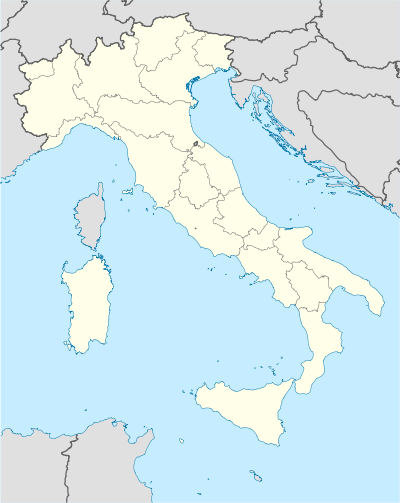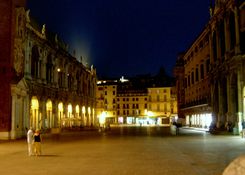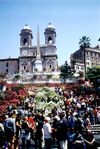Vicenza
| Vicenza | |
|---|---|
| — Comune — | |
| Città di Vicenza | |
 |
|
 Vicenza
|
|
| Coordinates: | |
| Country | Italy |
| Region | Veneto |
| Province | Vicenza (VI) |
| Frazioni | Anconetta, Bertesina, Bugano, Campedello, Casale, Debba, Longara, Maddalene, Ospedaletto, Polegge, San Pietro Intrigogna, Santa Croce, Tormeno |
| Government | |
| - Mayor | Achille Variati |
| Area | |
| - Total | 80 km2 (30.9 sq mi) |
| Elevation | 39 m (128 ft) |
| Population (31 December 2008) | |
| - Total | 115,279 |
| - Density | 1,441/km2 (3,732.1/sq mi) |
| Demonym | Vicentini |
| Time zone | CET (UTC+1) |
| - Summer (DST) | CEST (UTC+2) |
| Postal code | 36100 |
| Dialing code | 0444 |
| Patron saint | Madonna of Monte Berico |
| Saint day | September 8 |
| Website | Official website |
| City of Vicenza and the Palladian Villas of the Veneto* | |
|---|---|
| UNESCO World Heritage Site | |
 |
|
| State Party | |
| Type | Cultural |
| Criteria | i, ii |
| Reference | 712 |
| Region** | Europe and North America |
| Inscription history | |
| Inscription | 1994 (18th Session) |
| Extensions | 1996 |
| * Name as inscribed on World Heritage List. ** Region as classified by UNESCO. |
|
Vicenza listen, a city in north-eastern Italy, is the capital of the eponymous province in the Veneto region, at the northern base of the Monte Berico, straddling the Bacchiglione. Vicenza is approximately 60 km west of Venice and 200 km east of Milan.
Vicenza is a thriving and cosmopolitan city, with a rich history and culture, and many museums, art galleries, piazzas, villas, churches and elegant Renaissance palazzi. With the Palladian Villas of the Veneto in the surrounding area, and his renowned Teatro Olimpico (Olympic Theatre), the "city of Palladio" has been enlisted as UNESCO World Heritage Site since 1994.[1]
As of December 2008, Vicenza had an estimated population of c. 115,000,[2] and a metropolitan area of 270 000. Vicenza is the third-largest Italian industrial centre as measured by the value of its exports, and is one of the country's wealthiest cities.[3][4] Especially due to its textile and steel industries which employ tens of thousands and about one fifth of the country's gold and jewelry industry is made in Vicenza, greatly contributing to the city's economy. Another important branch is the engineering/computer components industry (Federico Faggin, the silicon chip's inventor was born in Vicenza[5]).
Contents |
History
Roman age
Vicentia was settled by the Italic Euganei tribe and then by the Paleo-Veneti tribe in the third and second centuries BC. The Romans allied themselves with the Paleo-Veneti in their fight against the Celtic tribes that populated north-western Italy. The Roman presence in the area grew exponentially over time and the Paleo-Veneti ( whose culture mirrored Etruscan and Greek values more so then Celtic ones ) were gradually assimilated. In 157 BC the city was a defacto Roman centre and was given the name of Vicetia or Vincentia, meaning "victorious".
The population of Vicentia received Roman citizenship in 49 BC. The city had some importance as a way-station on the important road from Mediolanum (Milan) to Aquileia, near Tergeste (Trieste), but it was overshadowed by its neighbor Patavium (Padua). Little survives of the Roman city, but three of the bridges across the Bacchiglione and Retrone rivers are of Roman origin, and isolated arches of a Roman aqueduct exist outside the Porta Santa Croce.
During the decline of the Western Roman Empire, Heruls, Vandals, Alaric and his Visigoths, as well as the Huns laid waste to the area, but the city recovered after the Ostrogoth conquest in 489 AD, before passing to Byzantine rule soon after. It was also an important Lombard city and then a Frankish centre. Numerous Benedictine monasteries were built in the Vicenza area, beginning in the sixth century.
Middle Ages
In 899, Vicenza was destroyed by Magyar raiders.
In 1001, Otto III handed over the government of the city to the bishop, and its communal organization had an opportunity to develop, separating soon from the episcopal authority. It took an active part in the League with Verona and, most of all, in the Lombard League (1164–1167) against Emperor Frederick I Barbarossa compelling Padua and Treviso to join: its podestà, Ezzelino II il Balbo, was captain of the league. When peace was restored, however, the old rivalry with Padua, Bassano, and other cities was renewed, besides which there were the internal factions of the Vivaresi (Ghibellines) and the Maltraversi (Guelphs).
The tyrannical Ezzelino III from Bassano drove the Guelphs out of Vicenza, and caused his brother, Alberico, to be elected podestà (1230). The independent commune joined the Second Lombard League against Emperor Frederick II, and was sacked by that monarch (1237), after which it was annexed to Ezzelino's dominions. On his death the old oligarchic republic political structure was restored -a consiglio maggiore ("grand council") of four hundred members and a consiglio minore ("small council") of forty members - and it formed a league with Padua, Treviso and Verona. Three years later the Vicentines entrusted the protection of the city to Padua, so as to safeguard republican liberty; but this protectorate (custodia) quickly became dominion, and for that reason Vicenza in 1311 submitted to the Scaligeri lords of Verona, who fortified it against the Visconti of Milan.
Vicenza came under rule of Venice in 1404, and its subsequent history is that of Venice. It was besieged by the Emperor Sigismund, and Maximilian I held possession of it in 1509 and 1516.
Modern age
Vicenza was a candidate to host the Council of Trent.
The 16th century was the time of Andrea Palladio, who left many outstanding examples of his art with palaces and villas in the city's territory, which before Palladio's passage, was arguably the most downtrodden and esthetically lacking city of the Veneto.
After 1797, under Napoleonic rule, it was made a duché grand-fief (not a grand duchy, but a hereditary (extinguished in 1896), nominal duchy, a rare honor reserved for French officials) within Bonaparte's personal Kingdom of Italy for general Caulaincourt, also imperial Grand-Écuyer.
After 1814, Vicenza passed to the Austrian Empire. In 1848, however, the populace rose against Austria, more violently then in any other Italian centre apart from Milan and Brescia ( the city would receive the highest award for military valour for the courage displayed by revolutionaries in this period ). As a part of the Kingdom of Lombardy-Venetia, it was annexed to Italy after the 3rd war of Italian independence.
Vicenza's area was a location of major combat in both World War I ( on the Asiago plateau ) and World War II ( a focal centre of the Italian resistance ), and it was the most damaged city in Veneto by Allied bombings, including many of its monuments; the civil victims were over 2,000. After the end of the latter, what followed was a period of depression following the devasatation caused by two world conflicts. In the 1960s the whole central part of Veneto, witnessed a strong economic development caused by the emergence of small and medium family businessess, ranging in a vast array of products (that often emerged illegally) that paved the way for what would be known as the "miracolo del Nordest". In the following years, the economic development grew vertiginously. Huge industrial areas sprouted around the city, massive and disorganised urbanisation and employment of foreign immigrants increased.
Vicenza is home to the United States Army post Caserma Ederle (Camp Ederle), also known as the U.S. Army Garrison Vicenza. In 1965, Caserma Ederle became the headquarters for the Southern European Task Force, which includes the 173d Airborne Brigade.
In January 2006 the European Gendarmerie Force was inaugurated in Vicenza.
Economy
The surrounding country is predominantly agricultural. Major products are wine, wheat, mais, olive oil ( in the Barbarano area ) and cherries and asparagus are a particularity of Bassano. There are also quarries of marble, sulphur, copper, and silver mines, and beds of lignite and kaolin; mineral springs also abound, the most famous being those of Recoaro. Massive industrial areas surround the city and extend extensively in the western and eastern hinterland, with numerous steel and tectile factories located in the Montecchio Maggiore, Chiampo and Sovizzo area in the west and Camisano Vicentino and Torri di Quartesolo in the east, areas characterised by a disorganised and extensive cementifaction. Elitè sectors are the jewelry and clothing factories. Important vicentino clothing firms include: Diesel, Pal Zileri, Marzotto, Bottega Veneta, Marlboro Classics etc.. The Gold Exposition is world-famous and it takes place in Vicenza three times per year (January, May, September). Other industries worthy of mention are the woollen and silk, pottery, and musical instruments. The headquarters of the bicycle component manufacturer Campagnolo and the protective wear for sports manufacturer Dainese are located here.
Demographics
In 2007, there were 114,268 people residing in Vicenza, located in the province of Vicenza, Veneto, of whom 47.6% were male and 52.4% were female. Minors (children ages 18 and younger) totalled 17.17 percent of the population compared to pensioners who number 21.60 percent. This compares with the Italian average of 18.06 percent (minors) and 19.94 percent (pensioners). The average age of Vicenza residents is 43 compared to the Italian average of 42. In the five years between 2002 and 2007, the population of Vicenza grew by 3.72 percent, while Italy as a whole grew by 3.85 percent.[6] The current birth rate of Vicenza is 9.16 births per 1,000 inhabitants compared to the Italian average of 9.45 births.
As of 2006, 87.53% of the population was Italian. From 1876 to 1976 it has been calculated that over a million people from the province of Vicenza have emigrated, with more than 3 million people of vicentino descent living around the world ( most common migrational currents included Brasil, America, Canada, Australia Germany, France, Belgium and Switzerland ) escaping the devastation left by poverty, war and sickness. Today nearly 100 000 Vicenza citizens live and work abroad. Today the city has morphed from land of emigration to immigration. The largest immigrant group comes from other European nations (the largest being Serbia, Albania, and Bosnia): 6.28%, South Asian 1.85%, sub-saharan Africa: 1.44%, and North Africa: 1.36%. Currently one quarter babies born in Vicenza has at least one foreign parent. The city is predominantly Roman Catholic, but due to immigration now has some Orthodox Christian, Muslim and Sikh followers.
Main sights



In 1994 UNESCO inscribed "Vicenza, City of Palladio" on its list of World Heritage Sites. In 1996 the site was expanded to include the Palladian villas outside the core area, and accordingly renamed "City of Palladio and the Palladian Villas of the Veneto".
Palladio's works
Vicenza is home to twenty-three buildings designed by Palladio. The famous ones include:
- Villa Almerico Capra (also known as "La Rotonda"), located just outside the downtown area;
- Basilica Palladiana, centrally located in Vicenza's Piazza dei Signori, of which Palladio himself said that it might stand comparison with any similar work of antiquity;
- Teatro Olimpico, designed for the Accademia Olimpica and begun to built in 1580, when Palladio died. The wooden scenes are by Vincenzo Scamozzi;
- Palazzo Chiericati, home of the Town pinacotheca;
- Palazzo Barbaran da Porto, home of the Museo Palladio;
- Palazzo del Capitaniato, home of the Town council;
- Palazzo Porto
- Palazzo Porto in Piazza Castello (unfinished)
- Palazzo Thiene Bonin Longare (built by Scamozzi)
- Palazzo Thiene;
- Villa Gazzotti Grimani, in the frazione Bertesina.
Other sights
Churches
- The cathedral (church of Santa Maria Annunciata), dating from early in the 11th century, and restored in the 13th, 16th, 19th and after the ruinous destruction of World War II, possesses numerous pictures and sculptures, nearly all of them by Vicentine artists (Cittadello, Celestia, Liberi, Ruschi).
- The Church of Araceli (1244), by Guarino Guarini, formerly belonged to the Clarisses, contains statues by Orazio Marinali and Cassetti, and paintings by Tiepolo.
- The Churches of the Carmini (1372) and St. Catherine (1292), formerly belonging to the Humiliati, possess notable pictures.
- Santa Corona (1260) was built by the Dominicans after the death of Ezzelino, and is pictured by Montagna (The Magdelene) and Bellini (Baptism of Christ); it also hosts the Valmarana chapel by Palladio.
- Santa Croce (1179)
- SS. Felice and Fortunato (8th century)
- SS. Filippo and Giacomo (12th century)
- S. Lorenzo of the Friars Minor (1280), in the Gothic style, contains the tombs of many illustrious Vicentines.
- In the cloister of S. Maria of the Servites (1319) took place the miracles of St. Philip Benizi de Damiani.
Secular buildings
- The Torre Bissara (clock tower) (1224–1446), 82mt, is one of the tallest buildings
- The Biblioteca Civica Bertoliana, public library founded by Count Giovanni M. Bertolo, opened 1708.
- Casa Pigafetta (1440), house of Antonio Pigafetta.
- The Pinacotheca Civica houses mainly Vicentine paintings in the Palladian Palazzo Chiericati.
Artists
Vicenza is the home of Rosalba Pedrina, a painter, sculptor, and art teacher. Her studio and art school are located in the Palazzo da Schio on Corso Palladio.
Sport
Vicenza is home to Vicenza Calcio who currently play in Serie B. Their home is the Stadio Romeo Menti.
Cuisine and popular dishes

Vicenza's cuisine, despite being Venetian in essence, is slightly different. Vicenza is known for its simple dishes, and often famous cheeses, fruits, ingredients and wines, such as Asiago cheese, Marostica cherries, Nanto truffles and Breganze Cabernet wine.
- Baccalà alla Vicentina
- Risi e Bisi
- Polenta e Osei
The inhabitants of Vicenza are jestly known to other Italians as magnagati 'cat eaters'. Purportedly, Vicentinos turned to cats for sustenance during times of famine, such as World War II.
Famous people from Vicenza
- Sonia Gandhi, Politician
- Amy Adams, actress
- Flavio Albanese, architect
- Roberto Baggio, football player
- Giuseppina M. Bakhita, saint
- Fernando Bandini, writer
- Valerio Belli, sculptor and engraver
- Maria Bertilla Boscardin, saint
- Ottavio Bertotti Scamozzi, architect
- Miki Biasion, rally driver
- Gelindo Bordin, athlete
- Roberto Busa, religious and informatic engineer
- Aulus Caecina Alienus, Roman general
- Tullio Campagnolo, bicycle maker
- Domenico Cerato, priest and architect
- Francesco Chieregati, papal nuncio, bishop
- Luigi Da Porto, writer
- Almerico da Schio, astronomer and inventor
- Otello De Maria, painter
- Ilvo Diamanti, political scientist
- Federico Faggin, inventor
- Adolfo Farsari, photographer
- Ferreto dei Ferreti, historian (fourteenth century)
- Antonio Fogazzaro, writer
- Antonio Giuriolo, partisan
- Fedele Lampertico, economist, writer and politician
- Niccolò Leoniceno, medic
- Paolo Lioy, naturalist
- Luigi Meneghello, writer (professor at Reading University)
- Francesco Muttoni, architect
- Andrea Palladio, architect
- Goffredo Parise, writer
- Rosalba Pedrina, artist and teacher
- Antonio Pigafetta, explorer, companion of Ferdinand Magellan
- Guido Piovene, journalist and writer
- Orlando Pizzolato, athlete
- Sergio Romano, diplomatic and historian
- Paolo Rossi, football player
- Mariano Rumor, politician
- Flo Sandon's, singer
- Vincenzo Scamozzi, architect
- Gian Antonio Stella, journalist and writer
- Tiziano Treu, politician
- Vitaliano Trevisan, writer and actor
- Gian Giorgio Trissino, humanist and poet (1478–1553)
- Nicola Vicentino, theorist and composer
- Giacomo Zanella, writer and priest
- Derozer, punk rock band
International relations
Twin towns - Sister cities
Vicenza is twinned with:
See also
- Diocese of Vicenza
- Caserma Ederle-US Army Post
References
Bibliography
 This article incorporates text from a publication now in the public domain: Herbermann, Charles, ed (1913). "Diocese of Vicenza". Catholic Encyclopedia. Robert Appleton Company.
This article incorporates text from a publication now in the public domain: Herbermann, Charles, ed (1913). "Diocese of Vicenza". Catholic Encyclopedia. Robert Appleton Company. This article incorporates text from a publication now in the public domain: Chisholm, Hugh, ed (1911). Encyclopædia Britannica (Eleventh ed.). Cambridge University Press.
This article incorporates text from a publication now in the public domain: Chisholm, Hugh, ed (1911). Encyclopædia Britannica (Eleventh ed.). Cambridge University Press.
Notes
- ↑ http://books.google.co.uk/books?id=_lG9LUf5esgC&pg=PA188&lpg=PA188&dq=teatro+olimpico+unesco+heritage+site&source=bl&ots=FAoaNtlkK5&sig=DKN2rV4JQVel1NV24HXPsSFfiRs&hl=en&ei=Bp_kSvn6N4Os4QbOqqz_AQ&sa=X&oi=book_result&ct=result&resnum=5&ved=0CBkQ6AEwBA#v=onepage&q=teatro%20olimpico%20unesco%20heritage%20site&f=false
- ↑ Data from ISTAT.
- ↑ http://www.vicenza.org/mosaic/economy.htm
- ↑ http://books.google.co.uk/books?id=_lG9LUf5esgC&pg=PA188&lpg=PA188&dq=teatro+olimpico+unesco+heritage+site&source=bl&ots=FAoaNtlkK5&sig=DKN2rV4JQVel1NV24HXPsSFfiRs&hl=en&ei=uJzkSqeNFtWw4QbdqvSDAg&sa=X&oi=book_result&ct=result&resnum=5&ved=0CBkQ6AEwBA#v=onepage&q=teatro%20olimpico%20unesco%20heritage%20site&f=false
- ↑ Article about Faggin posted on the website of the Institute of Electrical and Electronics Engineers
- ↑ Statistiche demografiche ISTAT:2007
External links
- Map of Vicenza
- Official site of the comune
- Heraldica.org- Napoleonic heraldry
- Video introduction to Teatro Olimpico by Andrea Palladio
|
|||||||||||||||||||||||||||||||
|
|||||||
_-_The_Last_Supper_(1495-1498).jpg)



